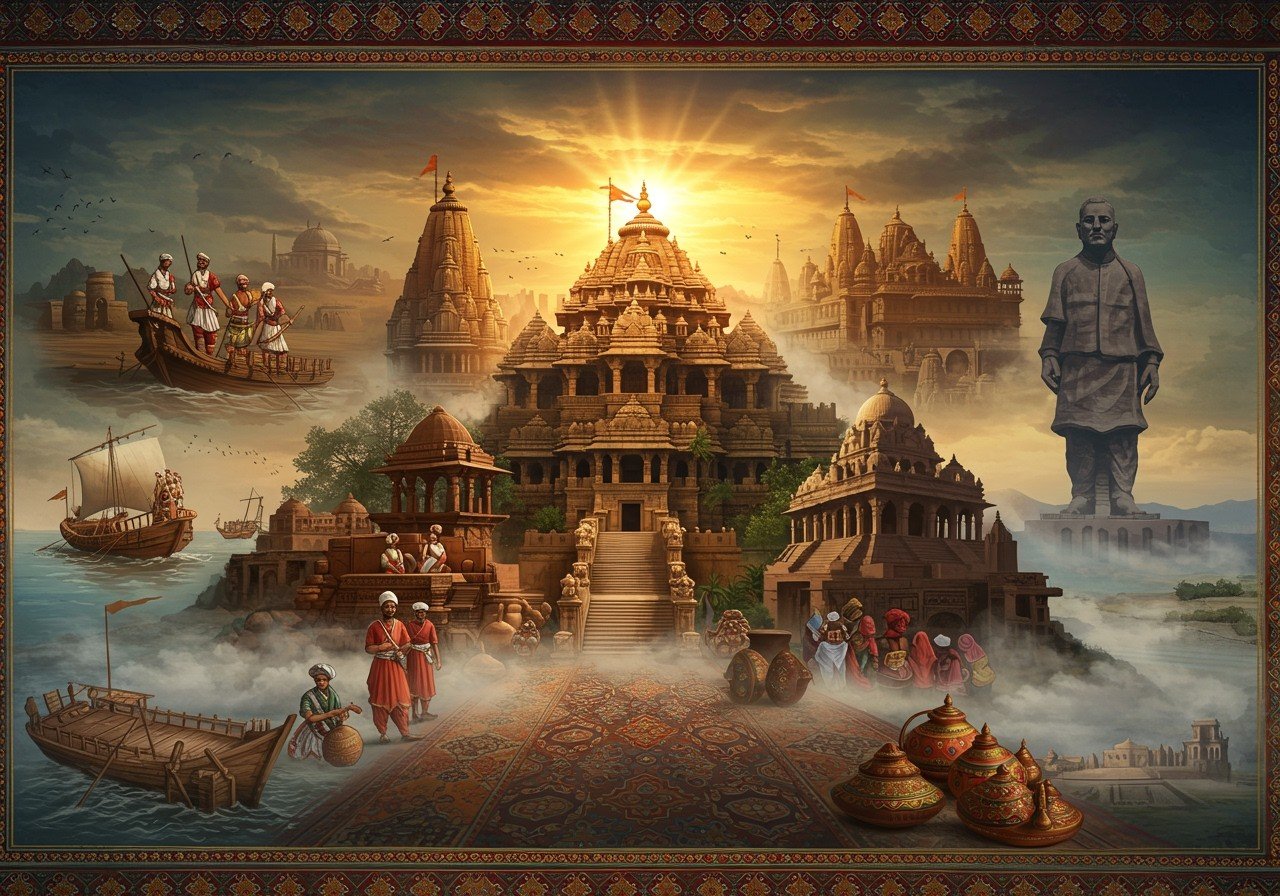
Gujarat, a vibrant state in western India, boasts a rich and diverse history spanning millennia. This article delves into Gujarat’s timeline, highlighting key periods from its ancient origins to its modern-day advancements. Understanding this historical journey allows us to appreciate the cultural heritage and significance of this remarkable region. From ancient settlements to contemporary developments, Gujarat’s story reflects resilience, innovation, and a vibrant cultural tapestry.
Early History (Ancient Period)
Gujarat’s early history is marked by the presence of ancient civilizations and powerful dynasties. The discovery of key archaeological sites provides a glimpse into the lives and accomplishments of these early inhabitants.
- Indus Valley Civilization (c. 2500-1900 BCE): Sites like Lothal and Dholavira reveal sophisticated urban planning, intricate drainage systems, and evidence of thriving maritime trade, indicating Gujarat’s early importance as a commercial center. Lothal’s dockyard, one of the oldest in the world, stands as a testament to the ingenuity of the people of that era. Dholavira, with its unique water harvesting systems, showcases their advanced understanding of urban infrastructure.
- Maurya and Gupta Empires (c. 322-550 CE): These periods witnessed the spread of Buddhism and Jainism, flourishing trade routes, and the establishment of educational centers. Ashoka’s reign during the Maurya Empire left a lasting impact on Gujarat’s cultural landscape. The Gupta Empire, known as the Golden Age of India, saw advancements in art, literature, and science, further enriching the region’s cultural heritage.
- Satavahana and Western Kshatrapas (c. 230 BCE – 405 CE): These dynasties played a crucial role in shaping Gujarat’s political and cultural development. The Satavahanas, known for their patronage of art and literature, left behind numerous inscriptions and monuments. The Western Kshatrapas, a Saka dynasty, controlled a significant portion of western India, including Gujarat, contributing to the region’s diverse cultural influences.
- Solanki Dynasty (c. 940-1244 CE): This era is renowned for its architectural achievements, exemplified by the magnificent Sun Temple at Modhera. The Solankis were great patrons of art and architecture, and their reign saw the construction of numerous temples, stepwells, and other structures, showcasing their sophisticated craftsmanship and artistic sensibilities.
- Chalukya Dynasty (c. 6th-12th centuries CE): Under the Chalukyas, Anhilwad Patan flourished as a prominent city, becoming a center of learning, culture, and commerce. The Chalukyas were known for their military prowess and administrative efficiency, which contributed to the stability and prosperity of Gujarat during their reign.
Medieval History (Medieval Period)
The medieval period in Gujarat witnessed the rise and fall of powerful dynasties, the establishment of new trade routes, and the fusion of diverse cultural influences.
- Chaulukya Dynasty (c. 942-1244 CE): This dynasty left behind remarkable architectural marvels, including the intricately carved Rani Ki Vav stepwell, a UNESCO World Heritage Site. The Chaulukyas also made significant contributions to literature and the arts, further enriching Gujarat’s cultural heritage.
- Delhi Sultanate (1206-1526 CE): The arrival of the Delhi Sultanate marked the establishment of Muslim rule in Gujarat, leading to a period of cultural exchange and syncretism. The interaction between Islamic and Hindu traditions resulted in unique architectural styles, literary works, and artistic expressions.
- Gujarat Sultanate (1407-1573 CE): Under rulers like Sultan Mahmud Begada, Gujarat experienced a period of prosperity and architectural innovation. Ahmedabad, founded by Ahmed Shah I in 1411, became a major center of trade and culture. Mosques, palaces, and tombs from this era showcase a blend of Indo-Islamic architectural styles.
- Mughal Empire (1526-1857 CE): The Mughal Empire’s influence brought about further integration of art, culture, and administration. Gujarat became a significant province within the Mughal Empire, and its cities continued to flourish as centers of trade and commerce.
- Maratha Empire (1674–1818 CE): The Marathas, emerging as a powerful force in western India, exerted considerable influence on Gujarat’s socio-political landscape during the 18th century.
Modern History (British Raj and Post-Independence)
Gujarat’s modern history is shaped by British colonial rule, the struggle for independence, and the state’s remarkable post-independence development.
- British Colonial Rule (1818-1947): The British East India Company’s arrival led to significant changes in Gujarat’s administration, infrastructure, and economy. The introduction of railways, educational reforms, and new administrative systems had a lasting impact on the region.
- Independence Movement: Gujarat played a pivotal role in India’s struggle for independence, with Mahatma Gandhi and Sardar Vallabhbhai Patel, two of the most prominent leaders of the movement, hailing from the state. Their leadership and philosophy of non-violent resistance inspired millions across the country.
- Formation of Gujarat (1960): Following independence, the Bombay state was divided, leading to the formation of Gujarat as a separate state on May 1, 1960. This marked a new chapter in the state’s history, allowing for focused development and governance.
- Post-Independence Development: Gujarat has witnessed remarkable economic growth post-independence, driven by industries such as textiles, petrochemicals, and pharmaceuticals. The state’s entrepreneurial spirit and focus on industrial development have transformed it into a major economic hub.
Poojn.in: Connecting with Gujarat’s Heritage
Poojn.in, India’s leading online store for cultural and religious products, offers a wide range of items that connect you with Gujarat’s rich spiritual traditions. From traditional Gongadi prayer mats to other essential puja items, Poojn.in provides authentic products that enhance your spiritual practice.
Explore our collection and discover how Poojn.in helps you embrace and celebrate the cultural heritage of Gujarat.
Related Articles on Poojn.in
- Sun Temple, Modhera: Your Complete Guide – Timings, Tickets, Hotels
- Konark vs Modhera: A Sun Temple Comparison – India’s Architectural Marvels
- Sun Worship in Hinduism: Exploring the Sun Temple’s Significance
- Gujarati Culture: Festivals, Cuisine, and Customs Explored


